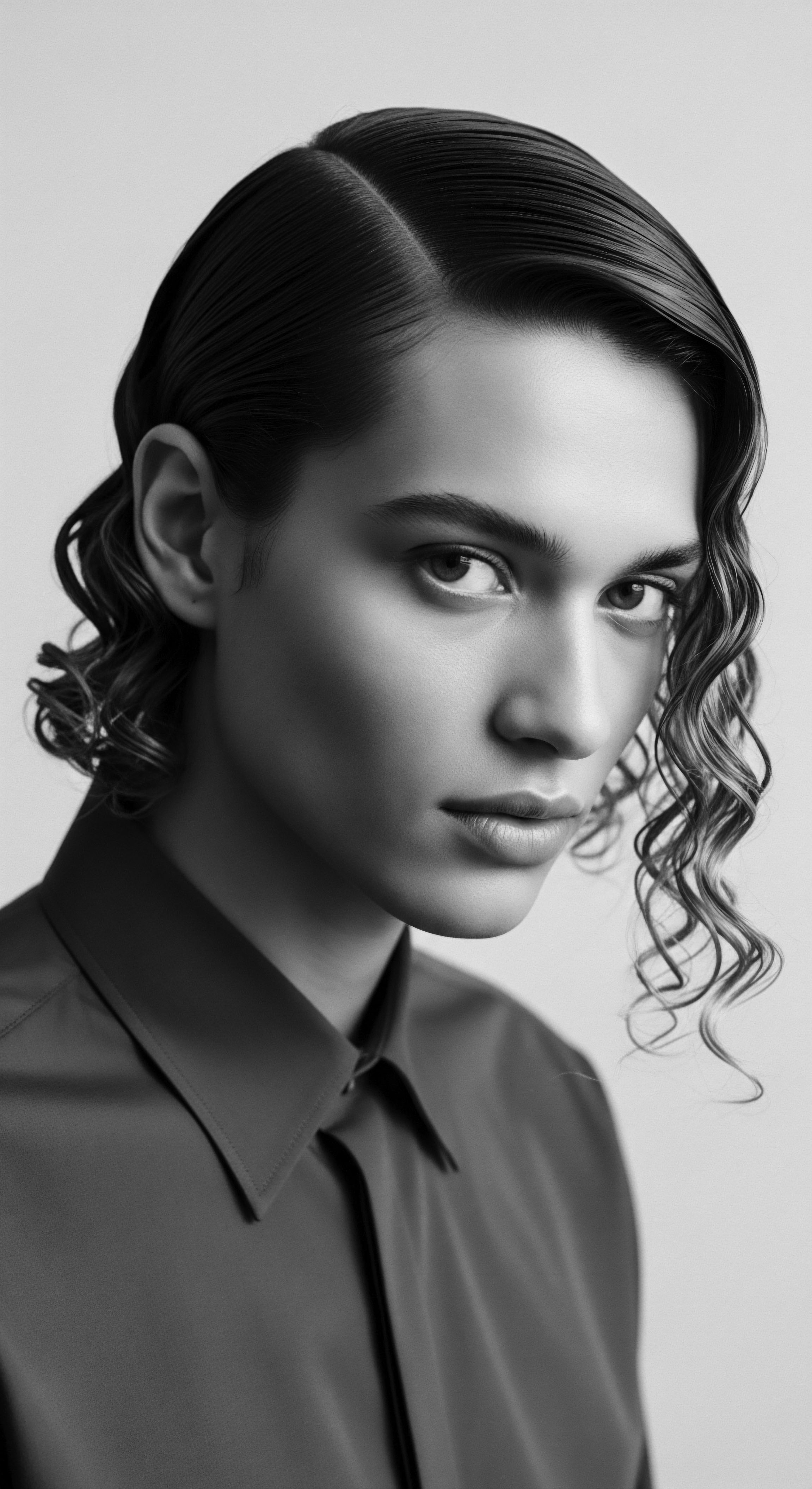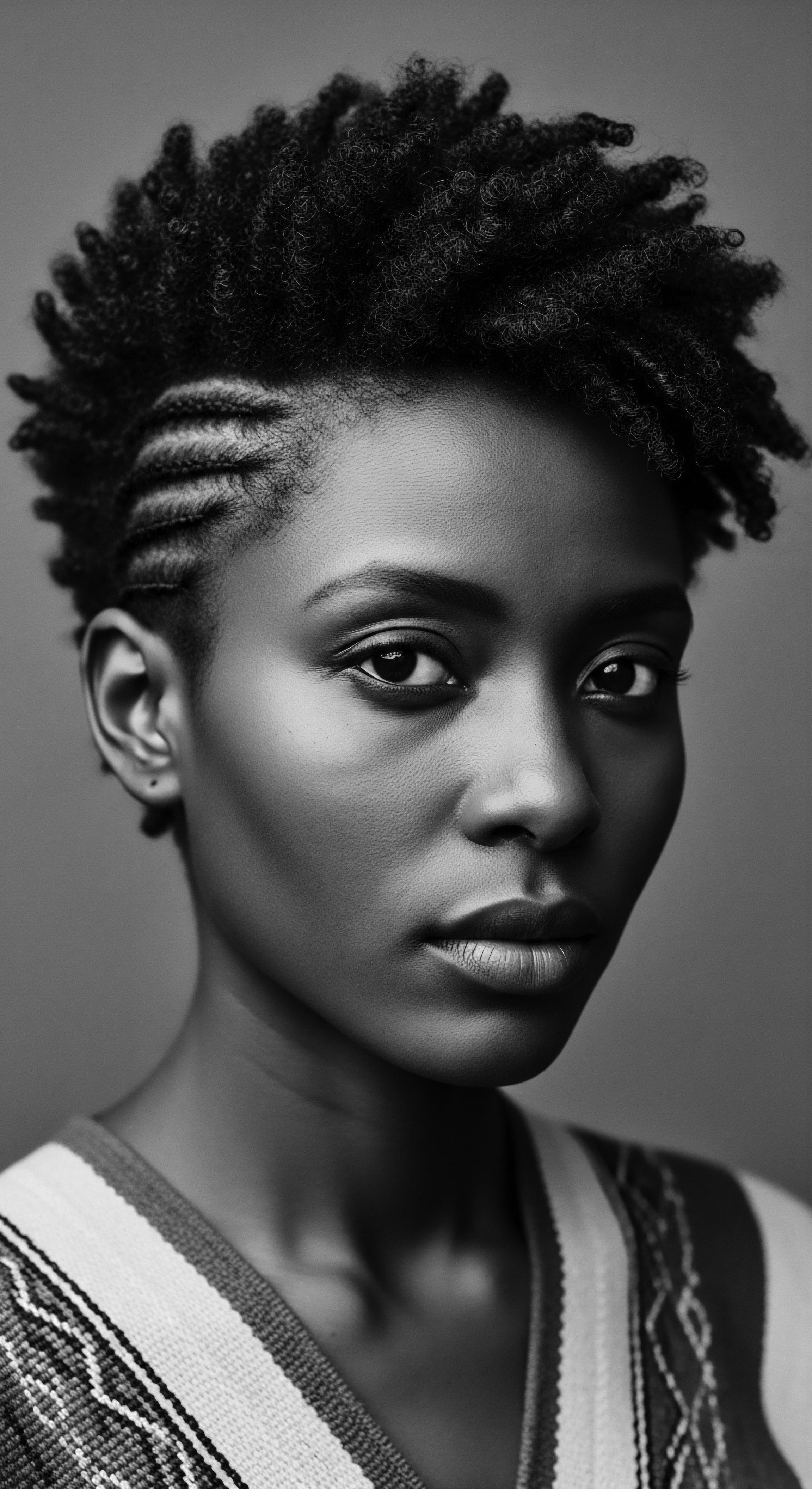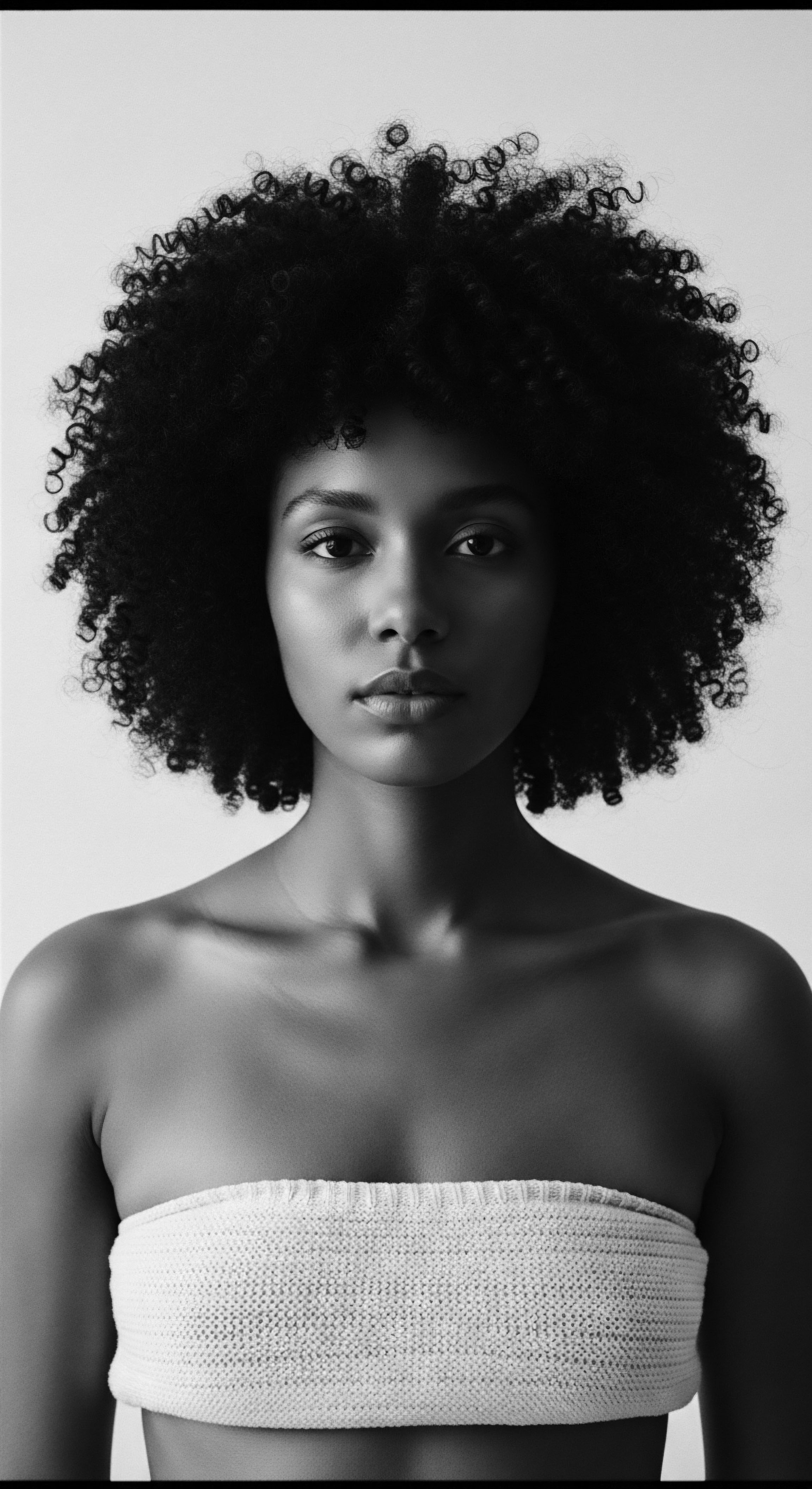
Roots
For those who wear it, textured hair is far more than mere adornment; it is a living chronicle, a testament spun from the very fibers of being. Each coil, every ripple, whispers tales across centuries, connecting us to a vast, inherited wisdom. To truly grasp its unique nature, we must look beyond the surface, discerning the foundational architecture that sets it apart. This journey into its elemental biology reveals not only scientific marvels but also echoes of ancestral understanding, shaping practices that have sustained its vitality for generations.

How Do Hair Follicle Shapes Influence Hair’s Growth?
The genesis of textured hair’s distinct form begins beneath the skin, within the hair follicle itself. Unlike the largely cylindrical follicles that give rise to straight or wavy strands, the follicles responsible for textured hair are often curved, almost like a gentle ‘S’ or a graceful retroverted shape. This curvature means the hair shaft does not emerge straight from the scalp.
Instead, it begins its ascent already turning, dictating the spiral path it will take as it grows. This subterranean curve is the primary architect of the hair’s characteristic coiling, determining the tightness and dimension of each curl.
This structural predisposition, observed keenly by traditional healers and hair tenders across various ancestral communities, informed their techniques. They understood, without modern microscopes, that textured hair did not flow freely in straight lines but possessed an inherent tendency to coil back upon itself. Their manipulations, therefore, were often designed to work with this natural inclination, rather than against it, ensuring styles held their shape and provided protection.

What is the Cross-Sectional Geometry of Textured Hair?
Consider a slice through a single strand of textured hair, and what emerges is not a perfect circle, but an ellipse—a flattened, oval-like shape. The degree of this flattening often corresponds to the tightness of the coil; a more pronounced ellipse generally indicates a more tightly curled strand. This elliptical geometry is a significant factor in how textured hair behaves.
Think of a flat ribbon; it bends more readily along its narrow axis, enabling it to form loops and spirals with ease. Similarly, the elliptical cross-section of textured hair allows it to coil and twist, contributing to its volume and distinctive patterns.
The intrinsic coil and elliptical structure of textured hair serve as a biological blueprint for its heritage of unique care and styling traditions.
This structural property also impacts how nutrients and natural oils traverse the length of the strand. Unlike straight hair, where natural sebum from the scalp can travel down a smooth, circular shaft with relative ease, the twists and turns of an elliptical, coily strand create natural barriers. This means the ends of textured hair can be particularly vulnerable to dryness, a challenge keenly understood by our ancestors who developed rich, emollient-based rituals to counteract this natural tendency. The emphasis on moisturizing butters and oils in ancestral practices speaks to an intuitive grasp of this biological reality, centuries before the scientific instruments confirmed it.

How Do Coiled Patterns Affect Hair’s Strength and Vulnerability?
The continuous coiling and twisting of textured hair, born from its curved follicle and elliptical shaft, create multiple points of fragility along each strand. Imagine a tightly wound spring; while it has elasticity, the bends themselves are areas where stress can concentrate. These natural bends and curves in textured hair mean it has a lower tensile strength compared to straight hair, making it more susceptible to breakage from mechanical stress, such as combing or stretching. This is not to say textured hair is inherently weak; it is, in fact, incredibly resilient in its collective form, but each individual strand requires a particular tenderness in handling.
The outer layer of the hair, the cuticle, which functions as a protective shield of overlapping scales, may also sit differently on textured strands. On highly coiled hair, these cuticle scales might not lie as flat as they do on straight hair, creating small openings. These microscopic liftings can allow moisture to escape more readily and make the hair more prone to damage from external factors, including environmental conditions. This biological feature explains why humidity can cause textured hair to shrink or revert to its natural coil and why moisture retention has always been a central tenet of heritage hair care.

Ritual
The distinctive architecture of textured hair—its elliptical shaft, its curved follicle, its inherent coil—did not exist in a vacuum. It gave rise to, and was shaped by, a wealth of ritualistic practices, tools, and communal gatherings that celebrated its unique properties. These rituals, passed through hands and memories, speak to a profound understanding of the hair’s needs, a knowledge deeply rooted in ancestral wisdom and lived experience.

What Styling Methods Honor Hair’s Natural Design?
Across the African continent and throughout the diaspora, generations refined styling techniques that worked in concert with the hair’s natural inclinations. Braiding, coiling, and threading were not mere fashion statements; they were ingenious responses to the hair’s structural composition. The tight, often intricate patterns of cornrows, for instance, not only created visually stunning art but also served a practical purpose ❉ they minimized tangling, protected the delicate strands from environmental exposure, and retained moisture, all of which speak directly to the hair’s fragility and tendency towards dryness. The ability of textured hair to hold these complex styles, due to its inherent coil and friction between strands, made these protective measures incredibly effective and enduring.
Consider the ancient practices of threading, where natural fibers or threads were wound around sections of hair, gently stretching it without heat. This method, observed in various West African countries, temporarily altered the coil pattern while preserving the hair’s integrity, allowing for length and manageability, a clever solution for strands prone to shrinkage. Such techniques showcase a deep, intuitive science at play, long before modern laboratories isolated keratin and disulfide bonds.
- Threading ❉ An ancestral technique involving wrapping hair with thread to stretch and protect strands, common in West African cultures.
- Bantu Knots ❉ Small, tightly coiled buns, originating with the Zulu people, serving both a decorative and protective purpose by keeping hair neatly contained.
- Cornrows ❉ Braids woven flat against the scalp in intricate patterns, providing organization, protection, and a historical means of communication and identity.

How Did Tools and Adornments Reflect Ancestral Ingenuity?
The tools employed in these rituals were extensions of the understanding of textured hair’s unique structure. Fine-toothed combs, crafted from wood or bone, were often designed to navigate the dense, coily landscape with care, minimizing snagging. Similarly, the use of natural substances—shea butter, various plant oils, and herbal infusions—was central to ancestral hair care. These emollients, rich in lipids and humectants, directly addressed the hair’s tendency toward dryness, coating the elliptical shaft and sealing the cuticle to maintain suppleness and prevent breakage.
The significance of these practices extends beyond mere utility. Hair styling was often a communal event, a space for storytelling, bonding, and the transmission of cultural knowledge from elders to younger generations. The careful hands of a mother, grandmother, or community elder working through the coils of a child’s hair was a lesson in care, resilience, and identity. This shared experience solidified communal ties and instilled a profound respect for the hair itself as a symbol of heritage and belonging.
Ancestral hair practices, from intricate styling to the careful application of natural emollients, represent a sophisticated dialogue with textured hair’s intrinsic structure.
The persistence of these grooming practices across the African diaspora, even through periods of immense cultural disruption, speaks volumes. As Sybil Dione Rosado observes, the similarity in hairstyles and hair grooming practices shared by diasporic Africans today unveils enduring connections to sub-Saharan Africa. This continuation forms what Rosado terms the “grammar of hair,” a silent, powerful language that communicates shared identity and cultural belonging (Rosado, 2007).
This is a profound testament to how the unique structural properties of textured hair, enabling such complex and lasting styles, contributed to the preservation of cultural meaning in the face of adversity. The very coils and curves that made the hair structurally distinct also made it a canvas for cultural survival and expression.
| Aspect Hair Structure Awareness |
| Ancestral Approaches Intuitive understanding of coil, dryness, fragility through observation and generational wisdom. |
| Modern Perspectives Microscopic analysis confirms elliptical shaft, curved follicle, and cuticle lifting points. |
| Aspect Moisture Retention Methods |
| Ancestral Approaches Reliance on natural butters (e.g. shea, cocoa), plant oils, and herbal infusions. |
| Modern Perspectives Formulated products with ceramides, humectants, and occlusives, often inspired by traditional ingredients. |
| Aspect Protective Styling |
| Ancestral Approaches Intricate braiding, coiling, and threading techniques to minimize manipulation and shield hair. |
| Modern Perspectives Continued use of braids, twists, and locs, augmented by scientific understanding of tension and hair health. |
| Aspect Tools Employed |
| Ancestral Approaches Hand-carved combs, fingers for detangling and shaping. |
| Modern Perspectives Wide-tooth combs, specialized brushes, and tools designed to reduce friction and heat damage. |
| Aspect Communal Practice |
| Ancestral Approaches Hair grooming as a social ritual, knowledge transfer through direct interaction. |
| Modern Perspectives Online communities and digital platforms serving as new spaces for shared learning and support. |
| Aspect The enduring principles of care for textured hair have flowed seamlessly from ancestral wisdom to contemporary understanding, preserving a legacy of vibrancy. |

Relay
The journey of textured hair’s unique structure, from its biological roots to its expression in intricate heritage practices, carries forward into our present understanding. The relay of knowledge, both scientific and ancestral, now converges, allowing for a deeper appreciation of this hair type’s resilience, vulnerabilities, and profound cultural significance. Analyzing the complexities of textured hair from multiple perspectives reveals how its inherent design has shaped not only its physical properties but also its story through history.

How Do Structural Traits Relate to Hair Health Challenges?
The very characteristics that give textured hair its distinctive beauty—its tight curls, its elliptical cross-section, and the consequent points of curvature along the shaft—are also the source of its heightened vulnerability. These structural quirks mean that textured hair is more prone to dryness because natural oils from the scalp struggle to travel down the winding path of each strand. This inherent dryness, coupled with the potential for cuticle layers to be less tightly sealed, means textured hair requires constant, thoughtful moisture replenishment. Scientific studies confirm what ancestral practices long understood ❉ that this hair thrives on consistent lubrication and gentle handling.
Furthermore, the numerous bends along the hair shaft create natural weak points, making textured strands more susceptible to breakage under mechanical stress, such as aggressive detangling or excessive manipulation. Conditions like traction alopecia, for example, often arise from styles that place undue tension on these fragile points, a modern challenge that underscores the historical need for protective styles that respect the hair’s structural limitations.

Can Hair Structure Influence Its Interaction with Products?
The unique surface characteristics of textured hair also play a part in how it interacts with the world, including the very products we apply. The more open cuticle, a consequence of the hair’s coiled nature, means textured hair can absorb ingredients differently, sometimes requiring products with specific formulations to seal in moisture effectively. This biological reality speaks to the sophistication of traditional concoctions, often featuring rich, occlusive plant butters and oils. These ancestral ingredients, applied with mindful intention, formed a protective barrier, compensating for the hair’s natural tendency to lose moisture.
The structural nuances of textured hair dictate its needs, affirming ancestral care practices and informing modern product formulations for optimal health.
The disulfide bonds within the hair’s cortex also contribute to its curl pattern and elasticity. While chemically similar across hair types, the distribution and formation of these bonds in textured hair contribute to its spring-like quality. This understanding allows modern science to formulate products that work with, rather than against, this natural elasticity, seeking to enhance definition and resilience. The interplay between these scientific insights and ancestral knowledge provides a comprehensive framework for holistic care.
- Shea Butter ❉ A natural fat extracted from the shea tree nut, traditionally used for its deeply moisturizing properties to condition hair and scalp.
- Coconut Oil ❉ Derived from coconuts, this oil has been historically valued for its ability to penetrate the hair shaft, reducing protein loss and adding luster.
- Aloe Vera ❉ A succulent plant whose gel has been used in various cultures for its soothing and hydrating benefits for both scalp and hair.
Beyond the purely physical, the structure of textured hair has also carried immense symbolic weight. Its ability to be molded into elaborate, culturally specific styles—from towering crowns to intricate braids—made it a profound medium for expressing identity, status, and resistance. This deeply ingrained cultural aspect means that scientific understanding cannot be divorced from the broader human experience of textured hair. Its biological uniqueness allowed it to become a canvas for human creativity and a repository of history.

Reflection
The story of textured hair is one of enduring resilience, a testament spun through generations of nuanced care and profound cultural connection. From the subtle curves of its follicle to the spiraling helix of each strand, its structure is a biological marvel, a living archive that holds within its very architecture the wisdom of ancestral practices and the echoes of identity. We have witnessed how the unique elliptical cross-section and the inherent coiling dictated ancient rituals of protective styling and the application of nourishing emollients, knowledge passed down not through written texts but through the tender, knowing hands of community.
This journey through its form and function reveals a truth that Roothea has always championed ❉ that the true care of textured hair extends beyond superficial treatments. It is a dialogue with heritage, an appreciation for the intricate dance between nature’s design and human ingenuity. The scientific insights of today affirm the intuitive knowledge of yesterday, bridging what was once distinct into a unified understanding. As we continue to learn about the complexities of its protein structures and cuticle behavior, we are reminded that these discoveries do not diminish the power of inherited wisdom.
Instead, they illuminate the ‘Soul of a Strand,’ revealing its deep past, its vibrant present, and its boundless future. Textured hair, in all its varied, magnificent expressions, remains a symbol of strength, beauty, and an unbroken lineage.

References
- Matjila, C. R. (2020). The meaning of hair for Southern African Black women. University of the Free State.
- Nyela, O. (2021). Braided Archives ❉ Black hair as a site of diasporic transindividuation. York University.
- Rosado, S. D. (2007). Nappy Hair in the Diaspora ❉ Exploring the Cultural Politics of Hair Among Women of African Descent. University of Florida.
- McMichael, A. J. (2025). Historical Perspectives on Hair Care and Common Styling Practices in Black Women. Dermatologic Clinics, 43(1), 1-8.
- Khumalo, N. P. & McMichael, A. J. (2024). H04 A historical journey of the structure, texture, and identity of afro-textured hair. British Journal of Dermatology.
- Kowalski, K. (2024). Science works to demystify hair and help it behave. Science News Explores.
- Giacomoni, P. U. & Johnson, B. A. (2019). The what, why and how of curly hair ❉ a review. International Journal of Cosmetic Science, 41(6), 503-510.
- Gillespie, S. L. & Khumalo, N. P. (2019). Microscopic Characteristics Of Scalp Hair Subjected To Cultural Styling Methods In Ghanaian African Females. Journal of Dermatology and Skin Science, 3(4), 1-8.
- Johnson, D. A. & Bankhead, A. D. (2009). Hair Care Practices in African-American Patients. Seminars in Cutaneous Medicine and Surgery, 28(2), 103-108.
- Mboumba, J. (2024). The Genomic Variation in Textured Hair ❉ Implications in Developing a Holistic Hair Care Routine. Preprints.org.
